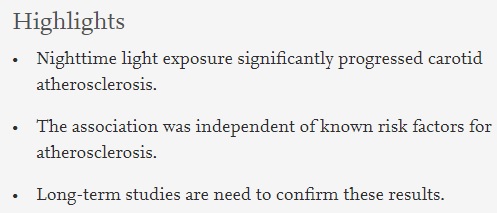Kenji Obayashi, Yuki Yamagami, Shinobu Tatsumi, Norio Kurumatani, Keigo Saeki,
Indoor light pollution and progression of carotid atherosclerosis: A longitudinal study of the HEIJO-KYO cohort, Environment International, Volume 133, Part B, 2019, 105184, ISSN 0160-4120,
https://doi.org/10.1016/j.envint.2019.105184.
(https://www.sciencedirect.com/science/article/pii/S0160412019309432)

Abstract
Exposure to light at inappropriate times in relation to the solar cycle can disturb circadian endocrine and metabolic rhythms. Previous studies have suggested an association between light exposure at night (LAN) and obesity, an important risk factor of atherosclerosis, although it remains unclear whether LAN associates with progression of atherosclerosis. To evaluate the longitudinal association between bedroom LAN intensity and progression of carotid atherosclerosis, light intensity in the bedroom at baseline and carotid artery intima-media thickness (IMT) at baseline and follow-up were measured in 989 elderly participants (945 at baseline and 780 at a median follow-up time of 34 months). The mean age of the participants was 71.4 ± 6.9 years. The average mean and maximal carotid IMT at baseline were 0.88 ± 0.15 and 1.10 ± 0.32 mm, respectively. The median intensity of bedroom LAN was 0.68 lx (IQR, 0.07–3.29). In multivariable analysis adjusted for potential confounders, the highest LAN group exhibited a significant increase in mean carotid IMT (adjusted β, 0.028; 95% CI, 0.005–0.052; P = 0.019) compared with the lowest LAN quartile group. A similar relationship was found between LAN and maximal carotid IMT (adjusted β, 0.083; 95% CI, 0.037–0.129; P < 0.001).
In conclusion, we found a clear and significant association between bedroom LAN intensity and progression of subclinical carotid atherosclerosis, which was independent of known risk factors for atherosclerosis, including age, obesity, smoking, economic status, hypertension, and diabetes. Indoor light pollution may be a potential risk factor for atherosclerosis in the general population.
https://www.sciencedirect.com/science/article/pii/S0160412019309432?via%3Dihub
